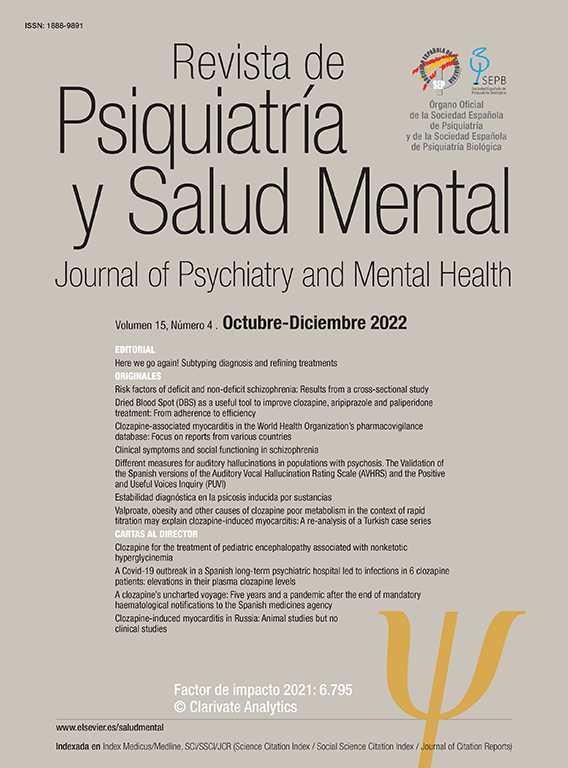The term ‘first-episode psychosis’ and the field's initial research on the subject were coined in 1991. First-episode psychosis was the topic of a workshop organized by the National Institute of Mental Health on February 8, 1991. The workshop was followed by a meeting at the International Congress on Schizophrenia Research in April of the same year, and the Schizophrenia Bulletin journal edited two volumes with the Issue Theme: First-Episode Psychosis on a wide range of FEP topics, such as phenomenology neuroimaging, neurocognition, and prospective studies, among others. These contributions were written for the most relevant researchers, and most of them continued to work in this field (Schizophrenia Bulletin vol. 18 (3), 1992).1,2 Since then, more than 800 articles were focused on the topic in PubMed and it is yet a trending topic in research in 2023.
After more than 30 years, significant progress has been made in the last years in understanding the genetic and environmental interplay in the etiology of psychosis. In addition, new consistent findings are coming from advances in basic sciences,3 phenomenology,4 neurocognition5 and neuroimaging domains6 and new interventions are evolving in the community for FEP patients.7 Moreover, the scope of interest was opened to study the premorbid and at-risk states and prodromal manifestations of FEP patients8 guiding some proposals for primary and secondary prevention.9 In addition, we have now substantial knowledge about clinical predictors of outcome of FEP patients from recent results of long-term studies focused on the trajectories of psychopathological dimensions (OPUS study10; SEGPEPS study8), cognitive and social functioning (SEGPEPS study11; The Suffolk County Study12), personal recovery (iHOPE Study13), and remission and recovery over the follow-up.14,15
The current SJPMH issue includes seven papers aimed to increase our understanding of FEP. Labad's perspective16 emphasizes the value of early services like the PAE-TPI pilot programs that were implemented in Spain's Catalan region. He also raises concerns over the variability of interventions and advocate for their assessment within the context of evidence-based interventions to improve program generality and homogeneity.
The heterogeneity of patients under the umbrella of FEP diagnosis should not be reduced to the assessment of single measures, such as clinical response. This is the point of departure for the FEPs early intervention program in Navarra (PEPsNa17), which aims to provide a two-year intensive care of FEP patients and to broaden the scope of outcome measures to account for unmet needs of recovery.
This issue also addresses the quest to refine the assessment of core domains in FEP patients, such as negative and disorganization symptoms, social cognition, and cognitive reserve (CR). Mezquida et al.18 showed that that predominant negative symptoms (PNS) were higher in males with FEP, but also that the clinical profile and risk factors for developing PNS differ between sexes. In addition, Magdaleno et al.19, examined a large data set of FEP patients and found that female patients showed higher CR than males in the verbal memory and processing speed domains, suggesting that the assessment of CR may lead to sex-specific cognitive remediation interventions. In fact, de la Serna et al. presented in this issue the first trial to examine the efficacy of an intervention to improve in clinical, cognitive and neuroimaging measures at a 1-year of follow-up in a sample of offspring of patients with bipolar disorder or schizophrenia disorders by an intervention specifically focused on enhancing CR. The disorganization dimension is usually neglected regarding other psychopathological domains. Therefore, Pelizza et al.20 carried out a 2-year follow-up of first affective psychosis (FEAP) and found that disorganized symptoms decreased over time and correlated with global psychopathological status. They suggested that disorganization could be a marker of early psychopathological severity in young FEAP patients.
Garrido-Torres et al.21 made a relevant translational contribution to this issue. They carried out a three-year prospective study of a large cohort of FEP patients, who were evaluated before antipsychotic exposure. They concluded that three simple and available determinations in every clinical practice—waist circumference, blood triglyceride, and high-density lipoprotein HD levels—are good predictors for patients at risk of developing metabolic syndrome at the 3-year follow-up, regardless of age, sex, and type of antipsychotic treatment. The assessment of these indicators from the first appointments of patients with FEP may contribute to improve their future physical health.
The present issue is a good example of the wisdom of forerunners researchers on PEPs that advocated in the two mentioned volumes of Schizophrenia Bulletin in 1992 that: “The ultimate goal is for researchers working in this area to develop a network to enhance the sharing of concepts and data ….”1 and that “We hope that the scientific progress, evident in these issues will provide the basis by which to better understand the nature of mental illness and provide relief for patients and their families experiencing schizophrenia and related disorders”.2
Thanks to continued research, FEP patients and their families can now receive the best evidence-based care. Future developments will focus on expanding our understanding of the neurobiological underpinnings of FEP and closing the translational gap from the etiology to the clinical domain. Nevertheless, closing the translational gap requires the development of new psychopathological strategies and hierarchical and dimensional models are promising methods.22 Furthermore, clinical staging models are currently accessible for use in clinical settings. These staging models cover all phases of the psychotic illness, from the symptomatic at-risk stage (stage 0) to the chronic, severe, and persistent illness (stage 4) and may allow for the personalization of interventions for each FEP patient.23
FUNDINGThis study was funded by a grant from the Carlos III Health Institute of the Ministry of Science and Innovation of the Government of Spain (PI19/01698).







